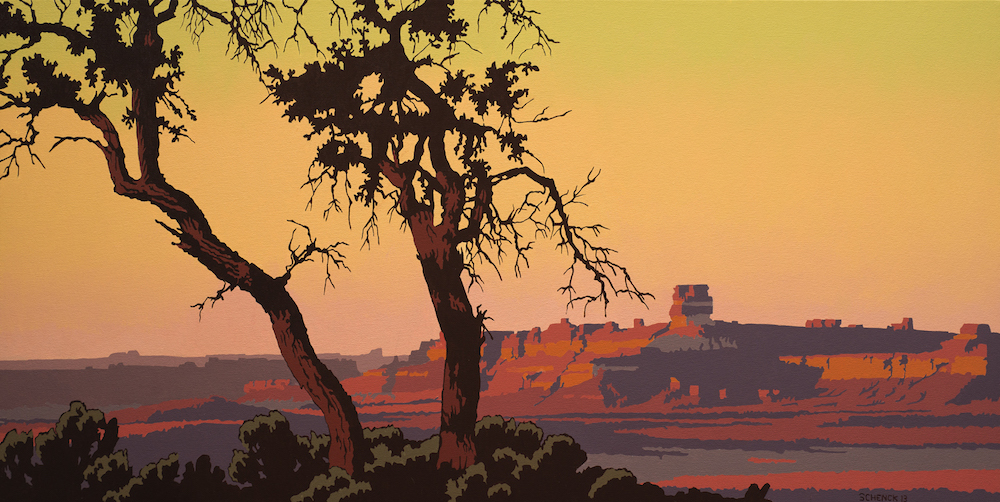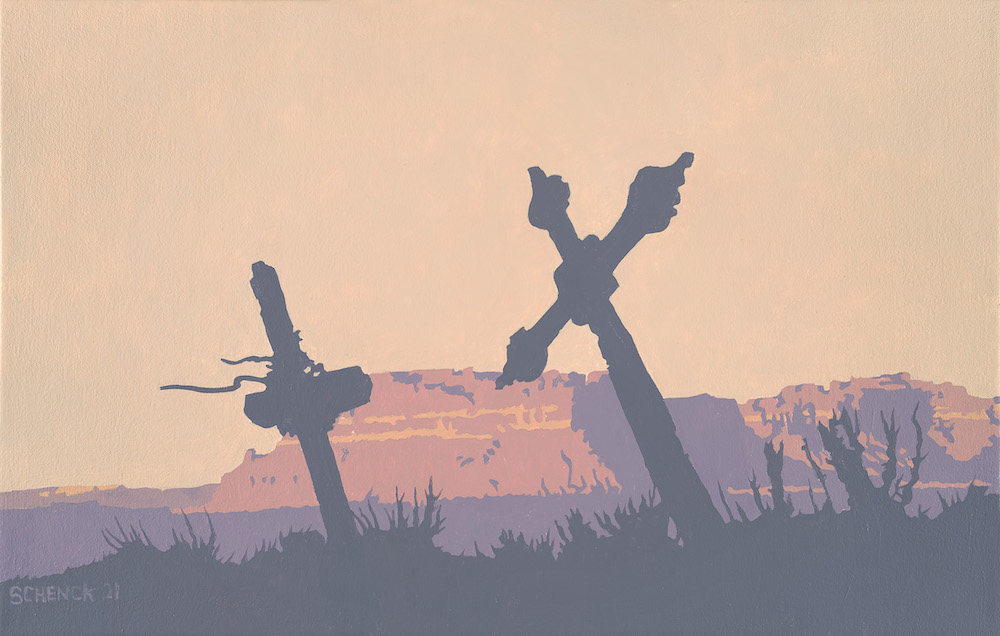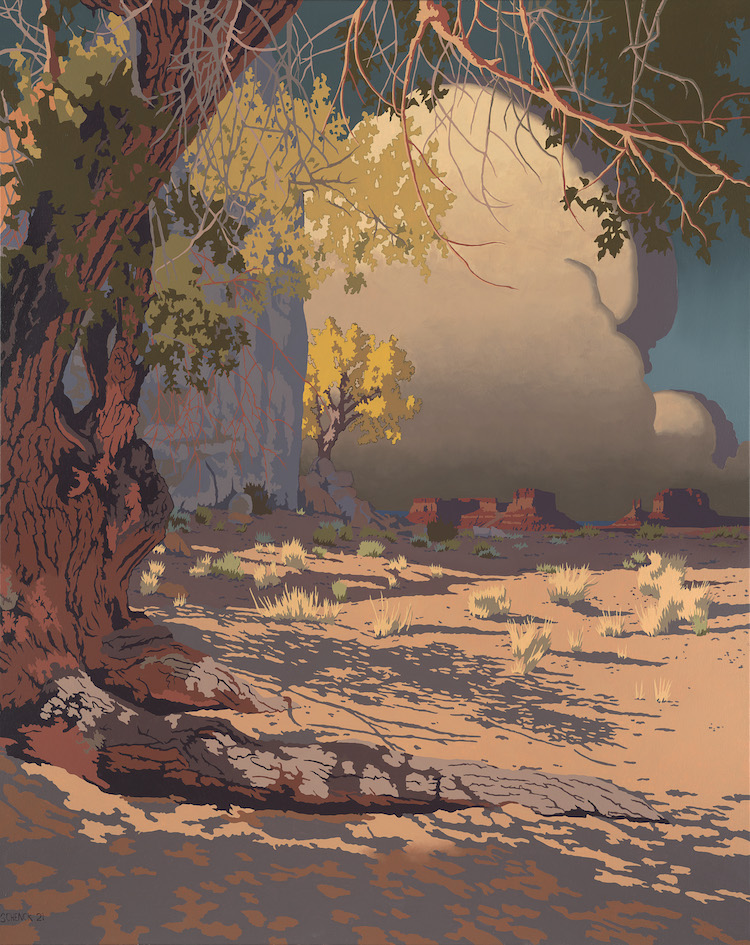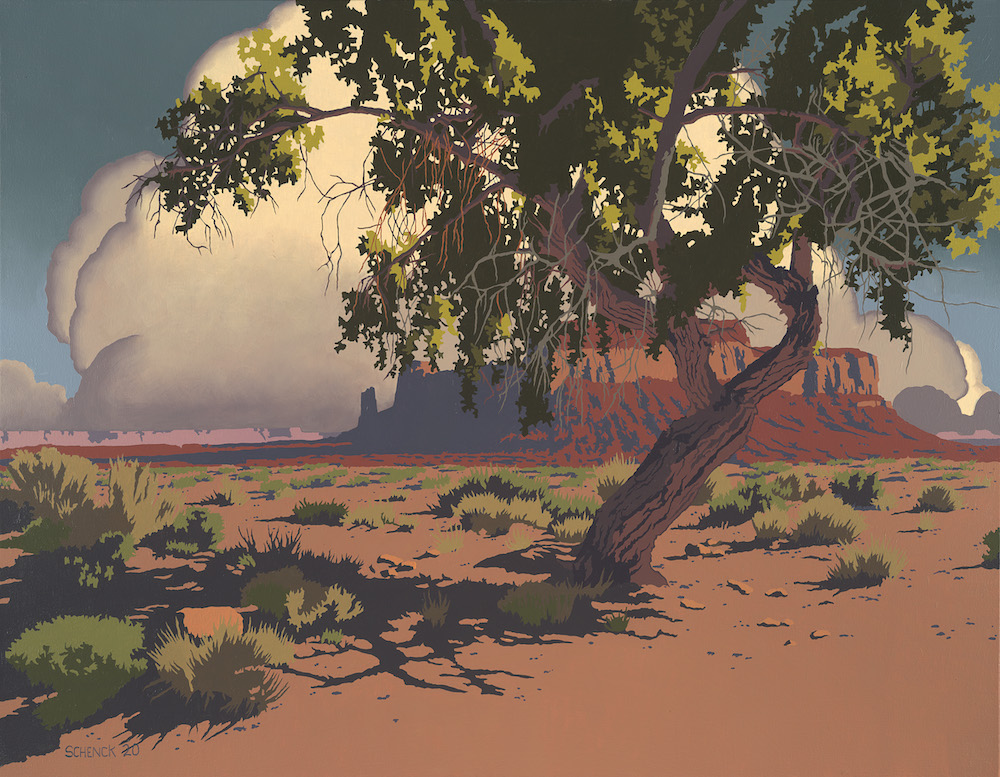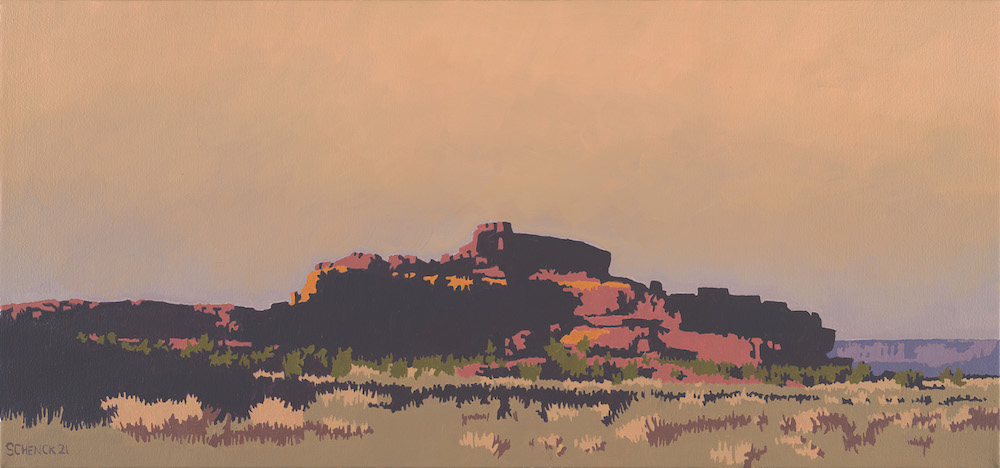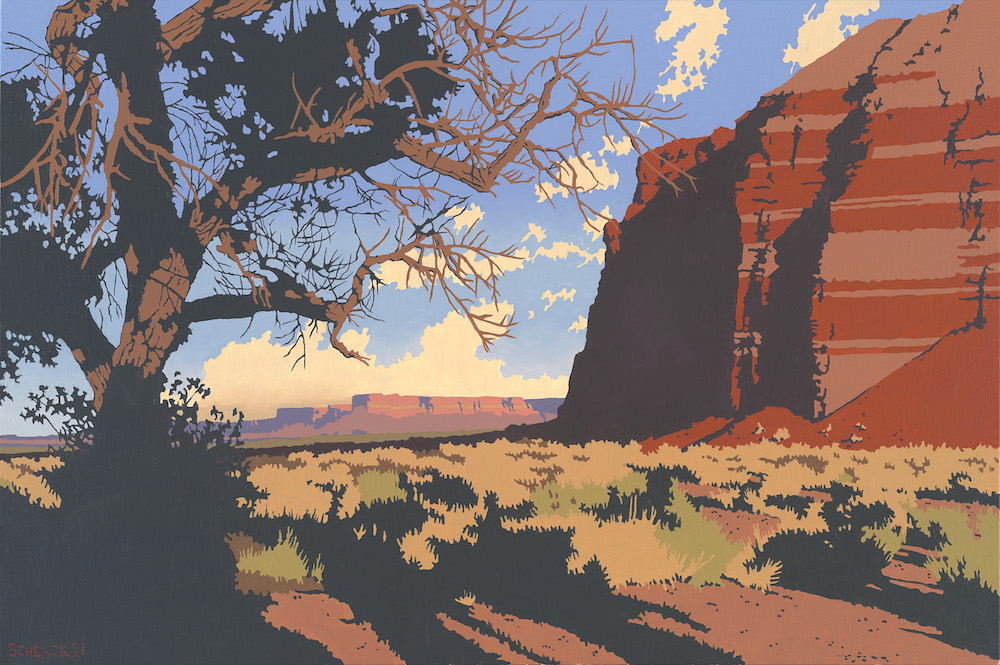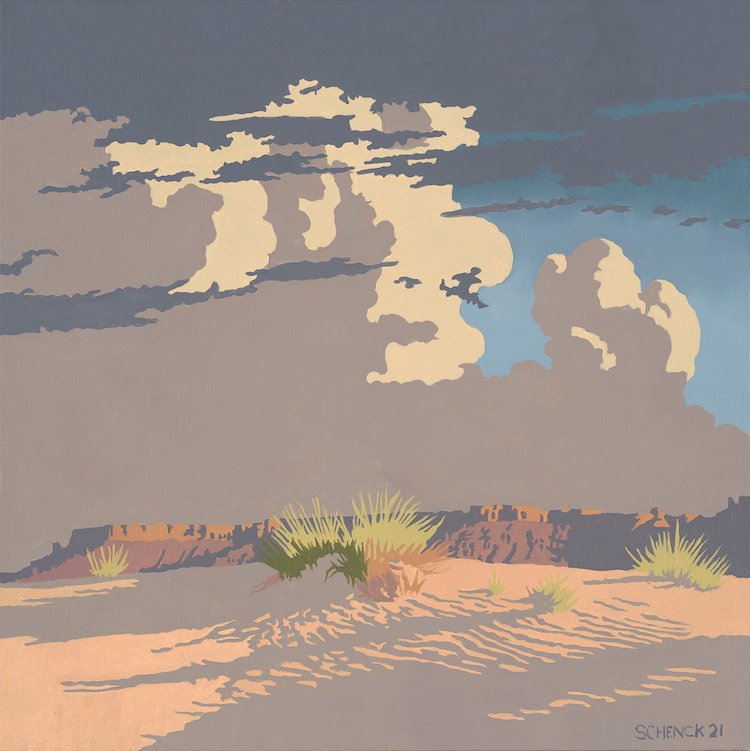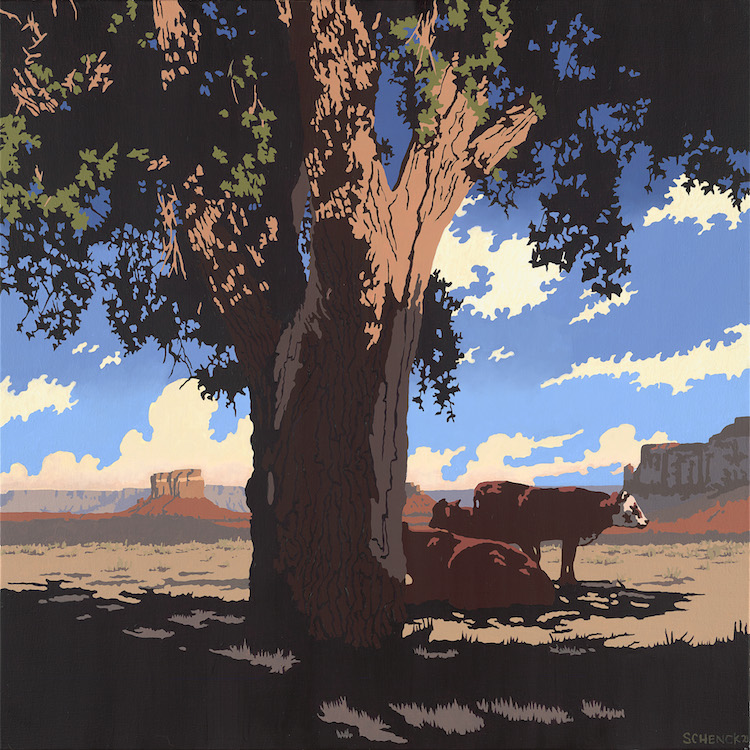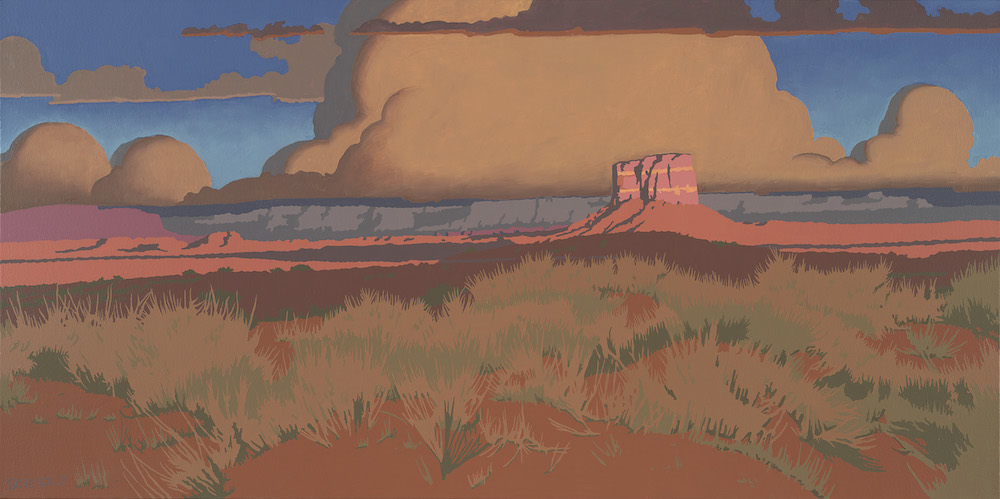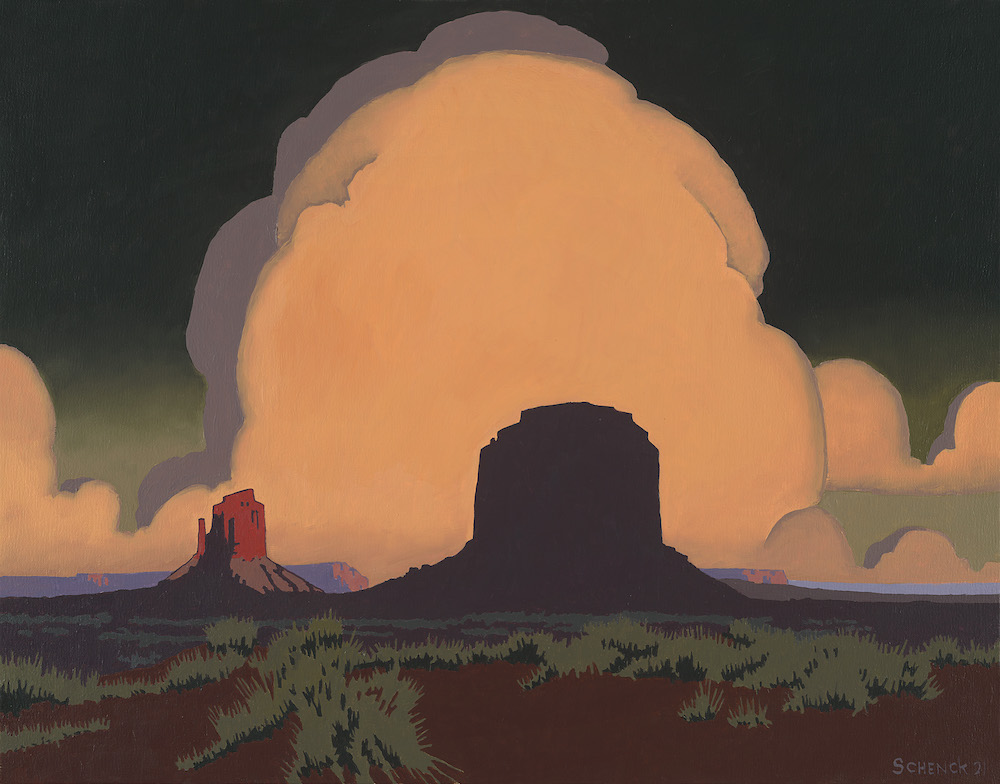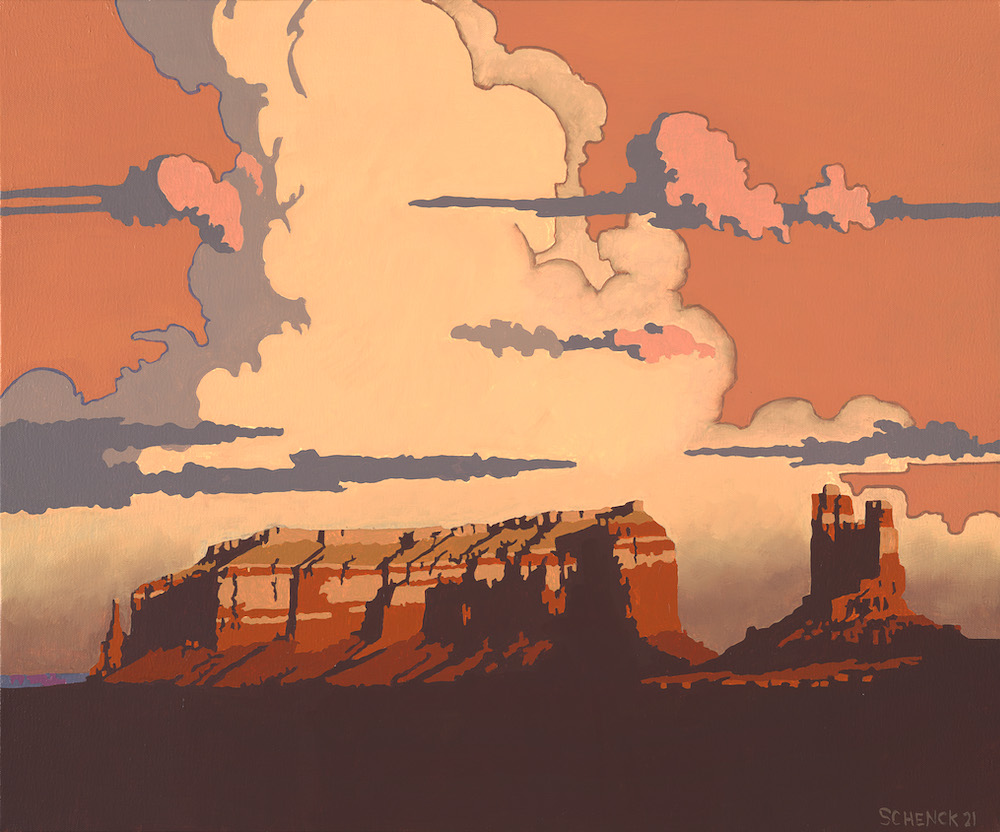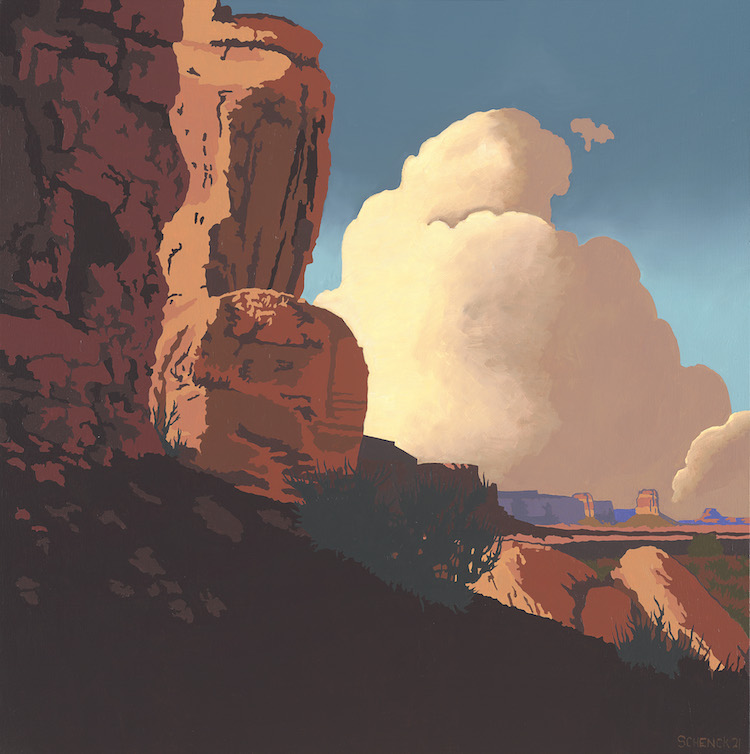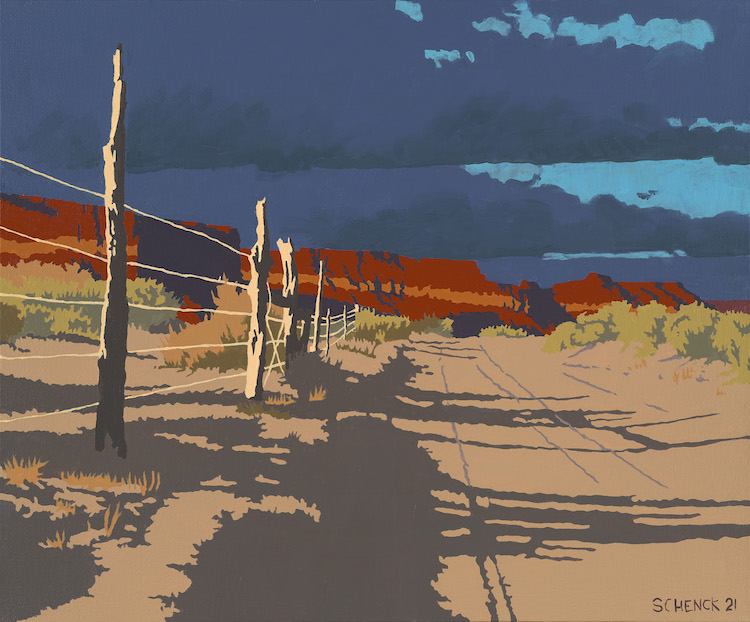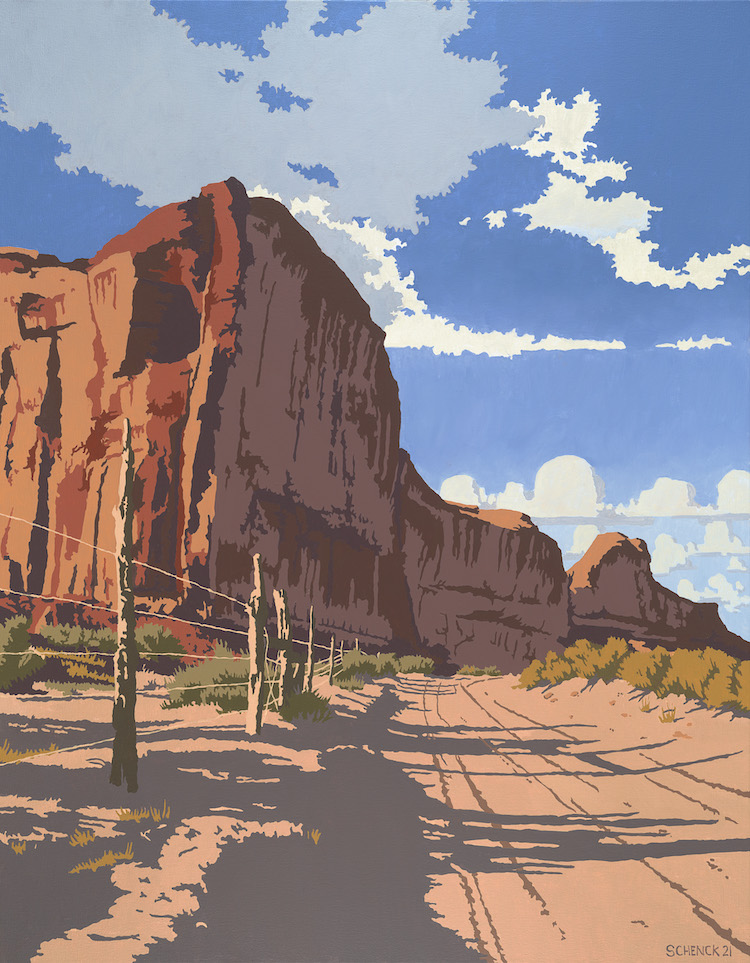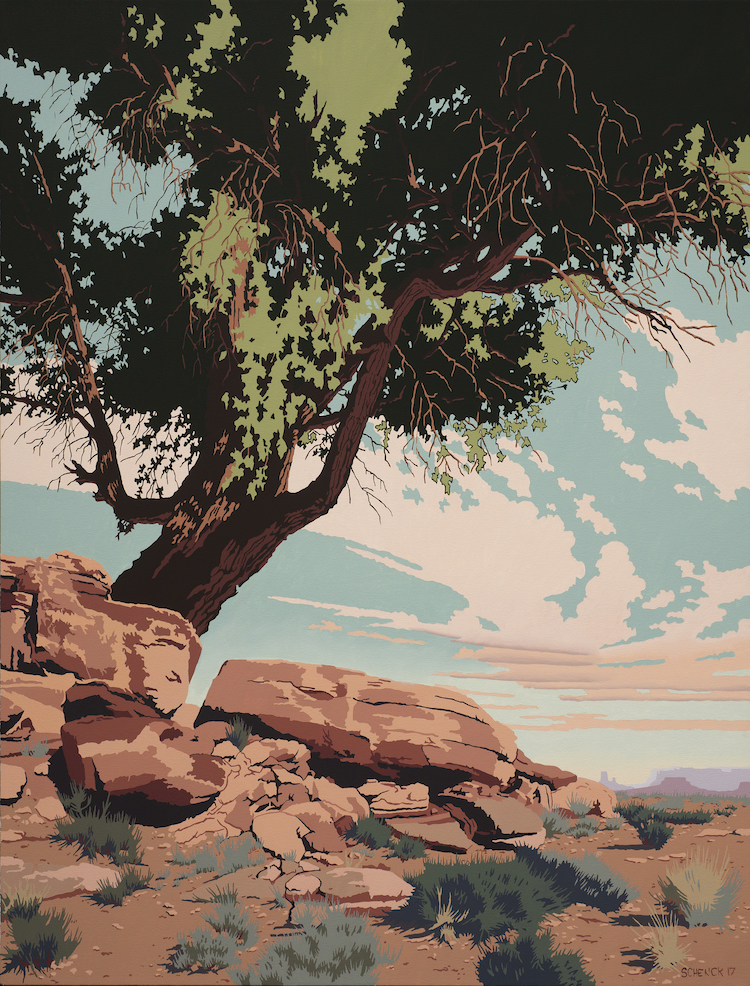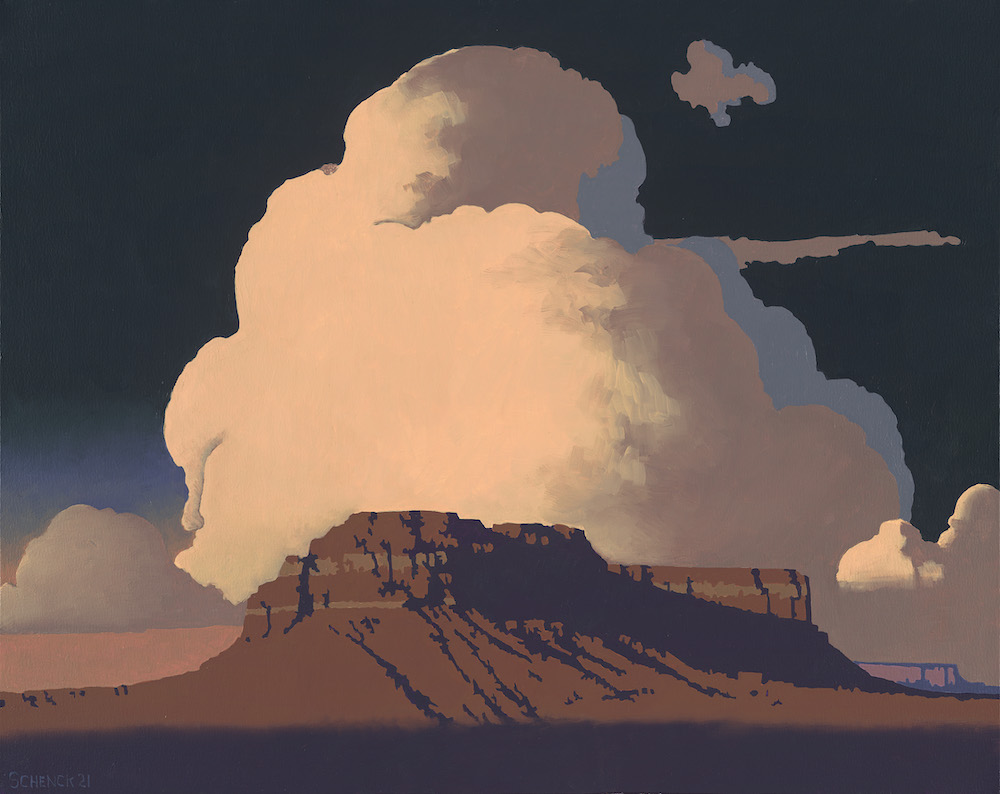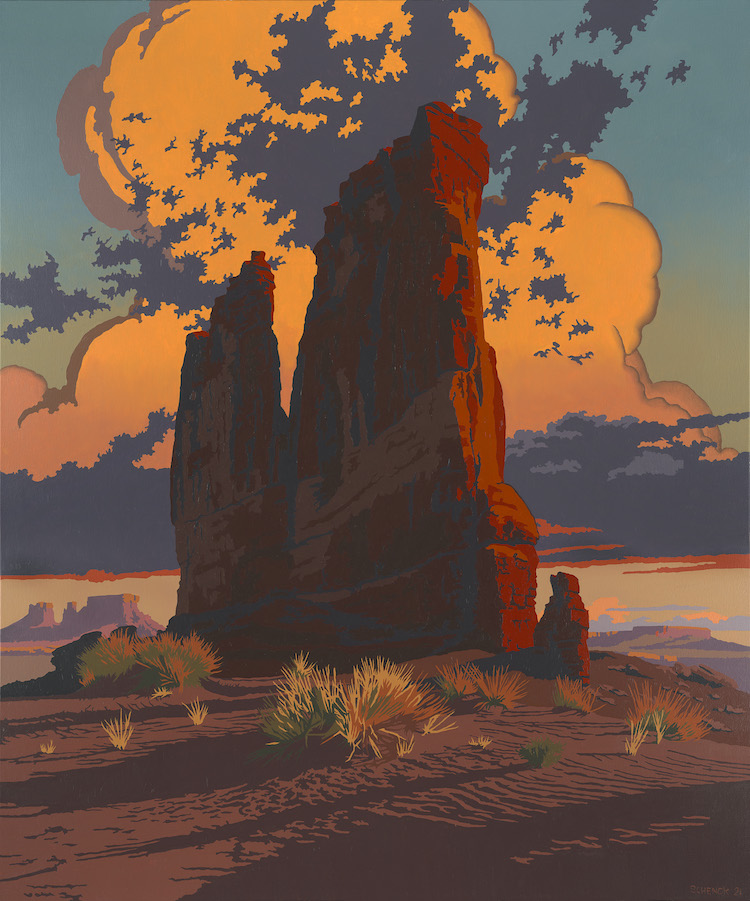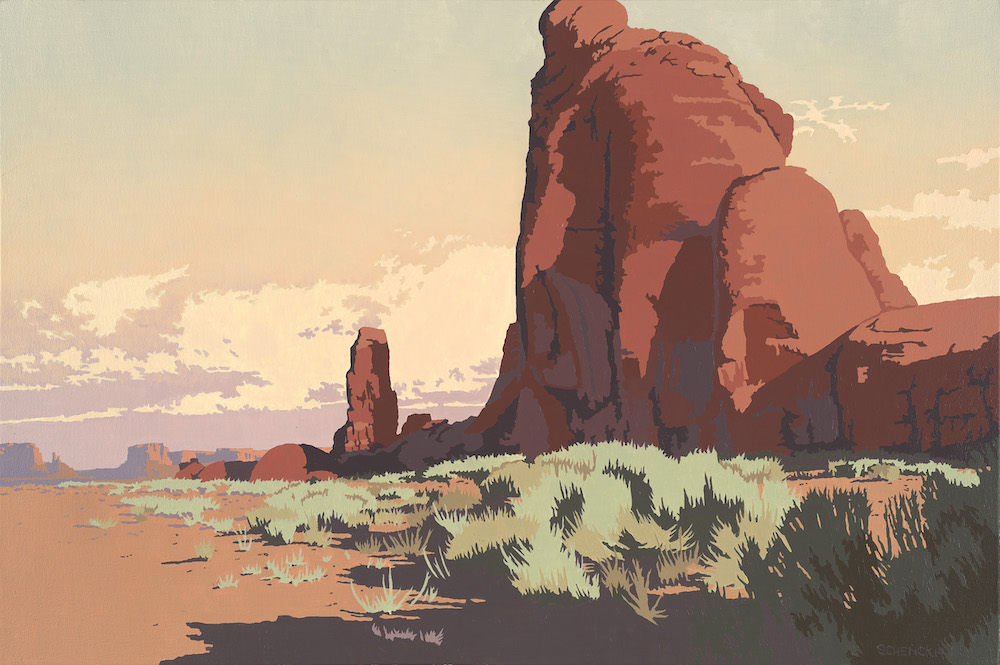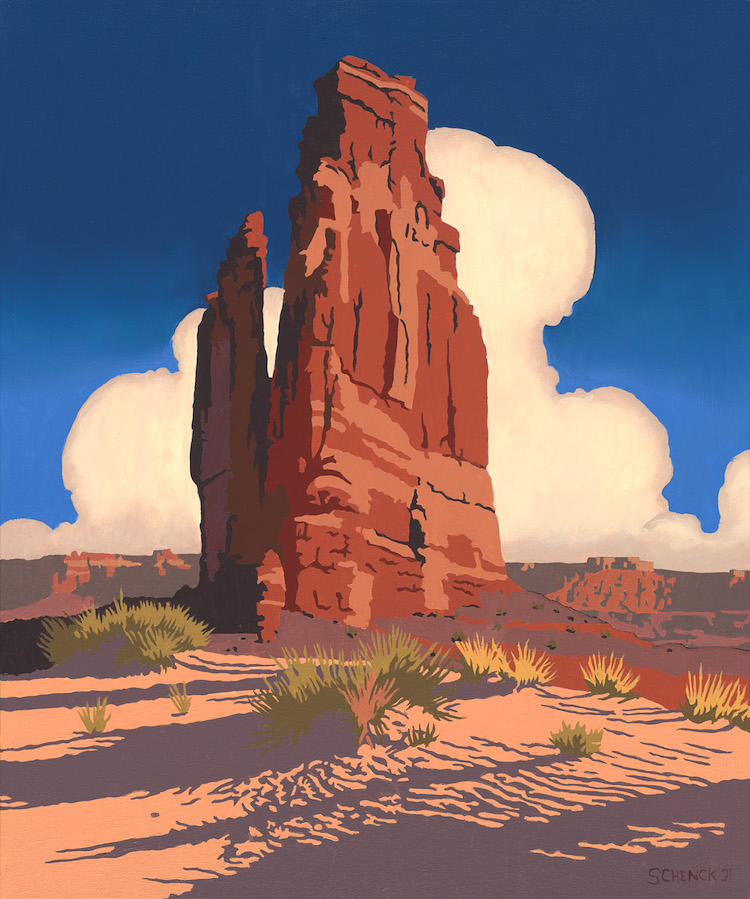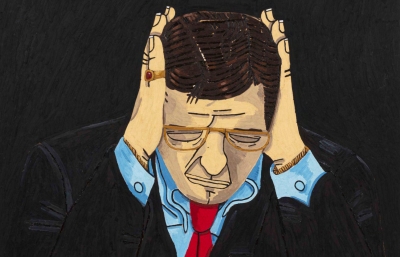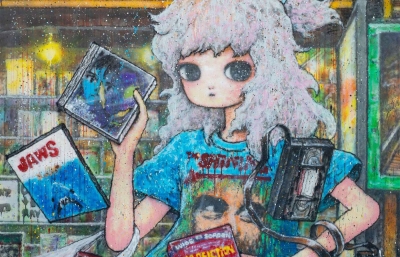"Utah is my favorite place on Earth," Billy Schenck says, and in the way he paints the landscape, you can definitely believe he is telling the truth. His colors are rich, his textures serene and almost surreal. After nearly a half century of exhibiting his paintings, Schenck is right at home in Utah, with a show of 19 new works at Modern West in Salt Lake City. Schenck's Utah | A Land Less Traveled finds the artist in a peaceful place, where a certain boldness in the landscapes he paints have a quiet, regal nature. We sat down with Billy to discuss what draws him to Utah, how he preps his works and his penchant for sunrises and sunsets.

Evan Pricco: Why do you think, or what is it, that makes Utah such an amazing place to paint? Is it the color?
Billy Schenck: I began making paintings based on black and white movie stills in 1970. As I quickly became familiar with the old black and white films, I found that I responded to the movies that had mesa/desert landscapes, such as the John Ford movies. I drove out to Monument Valley from New York in 1971. Then a life-long obsession began with the mesa country. The colors at sunset are just amazing in that country. The whole southern half of Utah has all that kind of country. I've explored lots of deserts but for me, nothing compares to what southern Utah has to offer.
I was trying to think of the American "look" in painting, and I was thinking Andrew Wyeth or Hudson River School, and I was sort of stumbling a bit on the Great West. I could think of Richard Prince, Ed Ruscha, but who are some of the quintessential western painters to you?
You mention Andrew Wyeth, I find him overwhelmingly boring, pedantic, and dozens of other negative adverbs. His father however is truly brilliant, N.C. Wyeth, particularly his work from 1904 to the late 1920s. The Hudson River School has good painters they just don't specifically speak to me. Richard Prince and I both made images and photographs based on the Marlboro Man advertising campaigns from the early 1970s. I made my first paintings referencing the Marlboro ads in 1973. Richard Prince began his Marlboro photos about eight years later. For whatever reasons, Prince's Marlboro photos sell for the low millions. Schenck Marlboro paintings sell in the mid thousands. Ed Ruscha, there is a career I am totally enamored with. I use words in my paintings, Ruscha does, and so does Prince. Ruscha's use of words is edgy, brilliant, funny, cryptic. Prince seems obtuse to me. When I grow up I want to be Ed Ruscha (although I am already 74.) Another Western painter that I greatly admire and study is Maynard Dixon. There are others such as Gerald Cassidy, Ernest Blumenschein(early work) and Victor Higgins (early work).
Are you looking for a story or landscape for inspiration?
No to story and yes to landscape. What I find fascinating is to go out into the desert to shoot slide film of landscapes that I think would be fabulous to use in paintings, but when I get back into my studio, I sometimes am shocked by how not good a lot of what I shot is. As in film, it's interesting what might look terrific is not necessarily all that interesting to the naked eye, and that works in reverse. I build my paintings from sometimes many different slides. I may like a sand dune or chamisa or sage brush from one slide and a mesa from another, rocks from another, and a cottonwood from another state possibly. Rarely are my landscapes just paintings of a single location. I build entire new landscapes to create a perfect world in my head.
Do you change up your process when you do landscape versus a more figurative scene? Are you going out and documenting landscapes before you paint?
Everything (pretty much) is projected imagery. I mostly work from foreground to background. In a painting that has figures, I may start with what I consider to be a dramatic foreground. My intention is to lead your eye into the composition, then float in the figure or figures next, then proceed into building the mid-ground going back to the background, and last up to the sky. Clouds are my own invention. Quite often I stretch shadows to make them longer. I like the drama that is created. Sometimes, as in film, I shoot day for night. When I paint a nocturn, the original reference is always from daytime slides.
Do you prefer a sunset or a sunrise?
I go out to Monument Valley and southern Utah locations about twice a year. That's been a ritual of mine for the last 50 years. I shoot in the early dawn light, then again at dusk. The rest of the day is down time, at least for shooting. I spend that time driving to look for potential locations to shoot later that day. The light is definitely different in the morning than what you find in the afternoons. Quite often I shoot the same locations both in the morning and again in the evening as the shadows are completely in reverse, which is great. At this point in my career, it is kind of irrelevant whether I shoot in the morning or evenings because I am not a slave to the local color. The palette I use in my paintings does not exist on this planet. I have been told by my Martian acquaintances that my landscape paintings sometimes makes them feel nostalgic for their home.
What is "quintessential Utah" for you?
The San Juan Inn at Mexican Hat on a rock shelf above the San Juan River. They have always had high-quality German beers. The San Juan Inn is basecamp for me since 1978. Driving from there, it might be on to Monument Valley and then on the road through Frye Canyon to Hites Landing and then up through the canyon on the way to Hanksville.
You had your first solo show in NYC in the 1960s, and have seen just a huge shift in the way people think about, consume and look at art. What is something essential you have learned over the years to stay motivated and inspired?
That is a huge question and an even huger answer. The first thing to consider is that when I came to New York in January, 1970, the only galleries in the country were in New York and a very very few in California. The American public had only been supporting American (contemporary) artists since 1962 with the advent of the Pop artists. An American artist, if you were lucky, could actually support yourself from your work. Prior to that era, everyone should read the book 9th Street Women by Mary Gabriel. It is the best written and most comprehensive book of the early 20th Century to the early 1970s American art scene in New York which was the center of the universe for contemporary art. My guess is that there were about 350 contemporary artists working in the whole country in 1970. Most were living in New York or in California. It was easy to keep track of all of them and their careers, you could see their work in the galleries. As there were so few, it was not an overwhelming experience. When Bob and Ethel Scull sold their Pop collection at auction at Sotheby's in the early 1970s, it became evident that a person could actually speculate an American artist, hold the work for a few years, and then sell it for a profit. It began happening again with the photorealists who I was loosely associated with. Every school of American painting began to gain traction as well as sculpture, earth art, conceptual art, etc. Galleries began to pop up in Dallas, Kansas City, Milwaukee, Chicago, Philadelphia.
In the early 70's it was a very big deal to get representation, and beyond that, to get a solo show. As the decades went by it just became a total explosion of artists, dealers, galleries, and everybody began getting solo shows. Having a solo show on your resume became almost irrelevant. The Covid era altered the whole art landscape again. Now people are buying art sight unseen on the internet and at auction. Next came NFTs (which only exist digitally). The infusion of money that has come into the art community in the last two decades is phenomenal. Artists can become millionaires. Art has become a commodity. Owing art has become a valid portion of a person's financial portfolio, along with their stock and real estate holdings. I do lectures on occasion at the museums all over the country and I always mention that for me there are several qualities that I believe you should have to be an artist. The first would be to have "authenticity of intent." The second element you must have is a signature style to your work along with a "voice." And lastly, perseverance. You must have absolute belief in who you are and the work that results from that belief. Get used to the idea there is no straight trajectory to fame and fortune. Get used to rejection, indifference and every other casualty that can happen in a lifetime.
What keeps my motivated and inspired is that my head has never stopped getting all kinds of ideas and I can't even begin to keep up with trying to get them formulated into a visually coherent image. Quite often my enthusiasm has led me to some incredibly moronic paintings. You may not know that at the time, but give it some weeks or months and your reflection might give you a more objective opinion. The flipside is, you may surprised at how sophisticated your thought process was at that time. Hopefully that happens more often than not.
Schenck's Utah | A Land Less Traveled will be on display at Modern West in Salt Lake City, Utah from January 21 through March 11, 2022.



